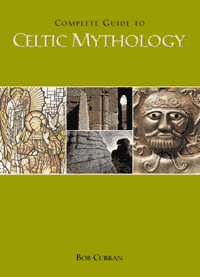 |


|
|||
 IN SEARCH OF ANCIENT IRISH HEROES - part 4 of 5 Cú Chulainn The only other Celtic warrior-figure who rivals Arthur in legend and mythology is the Irish champion Cú Chulainn who appears within what is known as the Ulster Cycle of myths. The name means, ‘The Hound of Culann’ although the prefix ‘Cú’ was a common designation for a warrior in early Irish literature. The title was used as late as the 12th century to denote a fearsome warrior – as in Cú Ultach O'Flynn, Lord of the Northern Shíol Cathasaigh, defeated near the mouth of the River Bush by the Norman knight John de Courcy in 1170. No evidence is given for the meaning of his second name, although several legends attempt to explain it. It is clear that he had his origins in a Celtic cult that venerated military prowess. It is possible that Cú Chulainn might not be a name but a title. The hero's real name is given in the earliest legends as Setanta, corresponding to the Celtic Setantii tribe in Britain. His favoured weapon is a mighty spear or javelin that is referred to as the ga, or gae, bolg (bolga) vaguely reminiscent of the Belgae, a well-known tribe in Western Europe. The name of his father-in-law, Forgall Manach, reflected the Menapii of Gaul. They, in turn, were supposed to have given their name to County Fermanagh in Ireland, Fir Manapii, the men of the Manapii. His birthplace was stated to be County Louth although this might have been only the site of his cult. The collection of seventh to ninth century additions to the central tale of Cú Chulainn was obviously thought necessary to provide some history for the hero. In creating this background, the ancient scribes caused great confusion by creating different myths about the hero's character and origins. The compiler of the first rendition of the Táin, which is a collection of oral tales relating to a war between Ulster and invaders from the Irish Midlands, faced the task of bringing these differing strands into a coherent whole. This explains many inconsistencies in stories surrounding Cú Chulainn's birth and boyhood and the ambiguity about his kinship to King Conchobar. The main ancient Irish text referring to the exploits of Cú Chulainn is the Táin Bó Cuailnge – The Cattle Raid of Cooley – and the hero's entrance into the narrative dated from around the seventh or eighth century. Early forms of the text attempt to link Cú Chulainn to the royal household of Ulster and to the Otherworld. His mother, the Ulster king’s sister, supposedly slept in the house of an Otherworld being at Brugh na Bóinne. Here she gave birth at the same time as a mare dropped two foals. The baby later became ill and died but was reborn again as Cú Chulainn. The true father of the child was revealed as Lúgh, God of Light. If he was of royal blood, then the latter tale was a fabrication designed to disguise King Conchobar's alleged incestuous relationship with his sister. Almost from infancy, the young Setanta displayed superior skills at hunting, athletics and war-craft. He could throw his famous javelin, the gae bolga, and catch it before it touched the ground. In one tale, an unspecified enemy surprised the Ulster men while the infant hero lay sleeping. On waking Setanta grabbed a hurley-stick and went to the battlefield where Conchobar and his men were being held prisoner. Belabouring the enemy, the child released the king and his son Cormac and brought them safely home. Additions to the texts in the late-eighth/early-ninth centuries seek to explain the origins of his name. While an infant, Cú Chulainn was unaccountably given in fosterage to a smith named Culann whose hound he accidentally killed. In a fit of remorse, he declared ‘I will be your hound’, hence the pre-fix ‘Cú’ – hound - and the name ‘Hound of Culann’. The title is taken to mean Warrior of Culann although just who or what Culann is unclear. The tale of the child’s slaying the monstrous hound of the smith Culann coincided with the monkish notion of monsters and giants that represented the forces of paganism (see Giants, Monsters and Fairies). It was crafted on to the central tales at a much later period, perhaps during the 10th or 11th centuries, probably to assert Man's superiority over the wildness of Nature. Some late medieval sources render the name as Cú na Ceirde, the ‘Hound of the Craftsman (or the Smith)’. Some folklorists suggest that the slaying of the beast might have marked an initiation rite that the young Setanta, in common with other young warriors, had to endure to join a Celtic warrior-cult. In the Táin, he successfully passed the test and became the ultimate warrior – excelling in athletic prowess and skills and an expert in weaponry. The very sound of his voice was so authoritative that it could strike terror into the soul of any foe. This Chapter extract concludes with In Search of Ancient Irish Heroes - Part 5>>>.
From Complete Guide to Celtic Mythology by Bob Curran |
[ Back to top ]
All Material © 1999-2009 Irelandseye.com and contributors

